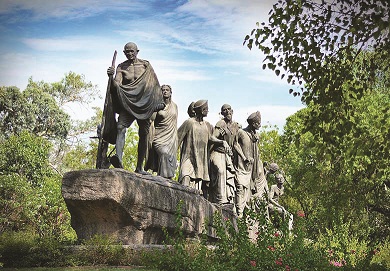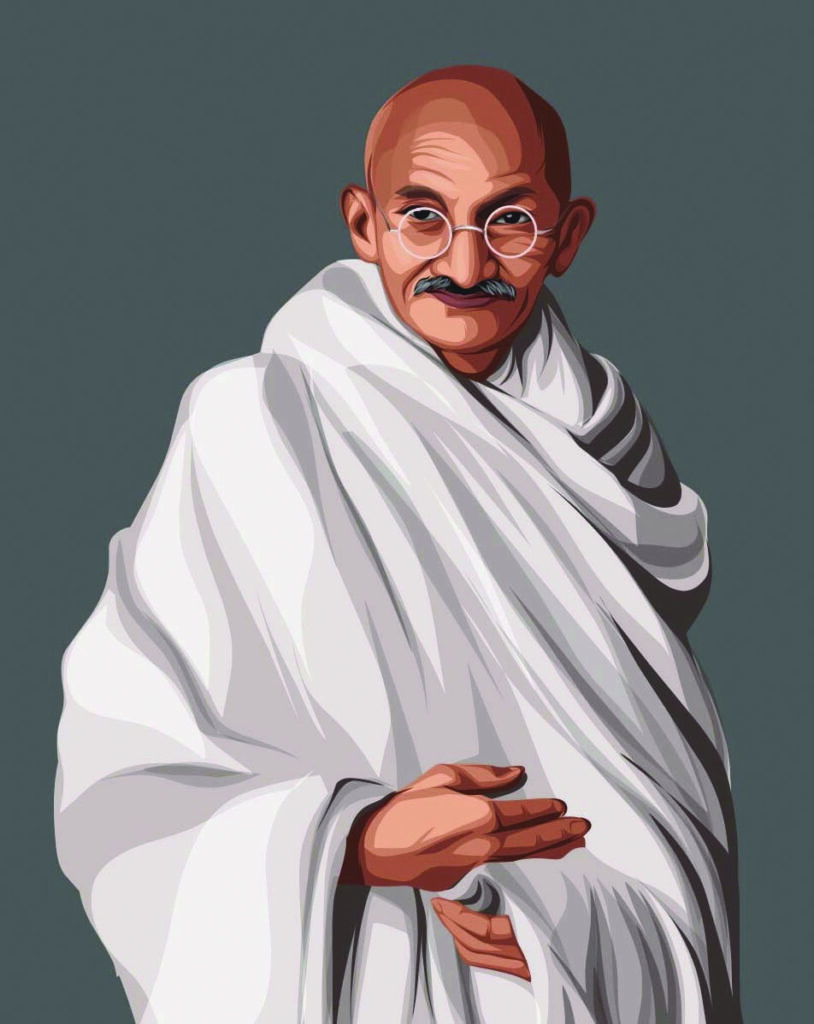Mahatma Gandhi was against the sort of modern economics, which is essentially violent and benefits the wealthy at the cost of the poor. The ideas of Gandhi haven’t lost relevance. They simply need to be rediscovered
By Alam Srinivas
- Mahatma’s Social Economy can play a huge role to alleviate poverty and achieve growth with a human face
- Mahatma Gandhi wanted people to use more and more renewable resources
- Local industries force workers, especially the youth, to acquire specialised skills easily and in a non-expensive manner
- Adam Smith believed that individual greed was always guided by the “invisible hand” (of God and/or market)
POVERTY among plenty! That’s the modern paradox, visible even in the affluent societies, which bamboozled and befuddled global policy-makers, economists, social activists, social scientists, and intellectuals.
For over 200 years, they blindly wavered between fears and hopes, optimism and pessimism. For over two centuries, they discovered, finessed, and used tools to find long-lasting solutions to their frustrations.
The science and maths of political economy seemed the way out for these well-meaning individuals.
Thomas Robert Malthus blamed population (sex and procreation). When people did well, they had larger families and, hence, were doomed as their living standards came down.
Other economists took this forward to contend that the income of a worker is destined towards a minimum, merely-sustainable, level in the long run. The confidence came from Adam Smith, who believed that individual greed, always guided by the “invisible hand” (of God and/or market), will invariably triumph.
A few fervently believed in interventions, either peaceful or violent. Alfred Marshall felt that every person could break out of the poverty chains through impetuses like education, since skilled workers were paid more than the unskilled ones.
Karl Marx advocated a revolution in which the workers (proletariat) came out as the winner. Although the nations are now divided between capitalists, socialists, and communists, they realise that the role of the state or government, in varying kind, is necessary, even inevitable.
HUMANE GROWTH
Everyone now talks of ‘growth with a human face’, and ‘inclusive growth’. However, most fail to recognise that almost a hundred years ago, Mahatma Gandhi, and his economic theorist, JC Kumarappa, talked in the same language. Theirs was a model of Social Economy, or Moral Economy, as opposed to political economy. The Gandhian ideology sought to improve the social values to better the economic environment, not economic growth to help the individuals to move up the social ladder.
Gandhi’s politics was planked on the twin concepts of Satya (Truth) and Ahimsa (Non-violence). He used both as the foundations of social values which, in turn, drove his economic thought. As Kumarappa espoused, economic truth was possible only if the national economies were aligned with the Natural Order of the universe. He wrote, “Everything in nature seems to follow a cyclic movement… A nation that forgets or ignores this fundamental process in forming its institutions will disintegrate.”
According to an article by Venu Madhav Govindu and Deepak Malghan, this imposed “deeply moral” and “ethical obligations” on the societies and individuals. They wrote that since humans “can comprehend the ideology underlying the Natural Order”, they have “a special moral obligation”, which “enjoins them to exercise their free will towards the betterment of societies”. Clearly, national economics stemmed from social values.
In strictly economic terms, this meant a change in mindset. For Kumarappa and Gandhi — an ideal Natural Order Public Finance, for instance, implied that “taxes should rise as the vapour from the sea, from the section of the populace who could best pay, and should be precipitated like rain on the needy”.
Later, the rain of money should find its way back into the sea of public finance through investments, consumption and savings.
STATE BENEVOLENCE
Thus, the State has to be benevolent. First, it has to tax the rich more than those lower in the hierarchy.
This corresponds well with the demand for a ‘super-tax’ on the wealthy. Second, it needs to spend more on the poor. This aligns perfectly with welfare economics, as explained by social activists like Beatrice Webb, politicians like Herbert Hoover (former US president), and economists like John Maynard Keynes, who fleshed out the theory of stimulus spending by the government during downturns and depressions.
In the Gandhian scheme of things, such policies, decisions and actions had to remain within the realm of non-violence. In the 1930s, when imperialism and mercantilism clashed with capitalism and socialism, Kumarrapa envisaged five kinds of socio-economic configurations. There were obviously the predators, who colonized and exploited other countries. Britain’s occupation of India was a prime example.
Then there were the parasites, which wholly and solely depended on others. Both were inherently violent.
Under other economies, like enterprise and gregation (from the Latin word ‘gregare’, which means a flock or herd), the violence was both evident and hidden. The lack of altruism, and the sharp focus on self-interest in enterprise economies, leads to exploitation. A revolution is required to change the order of things, which leads to more violence as is evident in Communist and state-controlled regimes. When people within a community cooperate, like bees, they clash with the other flocks and herds.

Gandhi’s politics was planked on the twin concepts of Satya (Truth) and Ahimsa (Non-violence). He used both as the foundations of social values which, in turn, drove his economic thought
As Govindu and Malghan pointed out, Kumarappa believed that the only non-violent option was an economy of service. Under this ideology, duties and obligations of the individuals were more important than their rights, which still existed. This was the way to base a society on “higher cultural values”, and the means for the moral and ethical to drive economics. This was an economy of permanence, as opposed to one of transience.
Such values had to be embedded within societies, either by governments, institutions, or societal ideologies. Aren’t these thoughts nearer to what Irving Fisher, an economist who emphasised interdependence of various elements in economics, meant when he said, “Not only is it false that men, when left alone, will always follow their best interests, but it is false that when they do, they will always thereby best serve society.”
More importantly, Winston Churchill, the former British prime minister, spoke the language of Gandhi and Kumarappa, when he said that “the State must increasingly and earnestly concern itself with the care of the sick and the aged, and above all, of the children. I look forward to the universal establishment of minimum standards of life and labour, and their progressive elevation as the increasing energies of production may permit”.
ECONOMIC NON-VIOLENCE
A key facet of a non-violent, natural order economy was the tussle between the use of renewable and non-renewable resources. Way back in the 1930s, both Gandhi and Kumarappa advocated a focus on the former and, hence, talked about green economy and green-led growth. He wanted economies to use more of cotton, timber, and water, or renewable resources, and which could grow due to the contribution of the societies. A corollary: limited use of non-renewable ones, such as coal, petroleum and minerals.
The emphasis of Gandhi-Kumarappa duo on village-based industries led to misconceptions that it was against technology and large-scale production. This wasn’t true. What it wanted was a complete decentralisation of the means of production at the local levels. This ensured that they were neither in hands of select companies, which led to monopolistic tendencies given the inherent ‘imperfect competition’ in market-led economies, or the State, and thus the few who ruled a nation, as in socialist and Communist ones.
What the duo wished for was more like a concept of a mixed economy, where certain sectors like railways and electricity were seen as “naturally centralised”, but the State retained control over them on behalf, and for the welfare, of the people. This ran hand-in-hand with the “support of village industries”, which led to a “necessary balance to maintain dependence of one on the other in society”. The crux lay not in abandoning “cottage units but to bring the light of science (technology) to cottage workers”.
PRESCIENT CONCEPT
Village-based production was a prescient concept. Over the past nine decades, it echoed well with Donald Trump’s ‘Made in America’, Britain’s Brexit, or exit from the European Union, Swadeshi Jagran
Manch’s ‘Made in India’, and Narendra Modi’s ‘Make in India’. It was a continuation of the theme of protectionism, which was furiously debated during the twentieth and twenty-first centuries in various countries. For example, Khadi entailed the urge to use local produce, as opposed to foreign goods.
This leads to several additional economic benefits. The first is that it addresses the issue of employment, and that too skilled one. Modern theories have concluded that large-scale production, and huge factories, results in growth without employment for various reasons. Technology makes labour redundant, and the trend is likely to enhance with the use of robotics and artificial intelligence. It requires specialised skills, which depend on higher education and elite social backgrounds deprived to the poor.

For Kumarappa and Gandhi–an ideal Natural Order Public Finance, for instance, implied that “taxes should rise as the vapour from the sea, from the section of the populace who could best pay, and should be precipitated like rain on the needy
Local industries force workers, especially the youth, to acquire specialised skills easily and in a non- expensive manner. This is evident from India’s accent on skill development for several decades. It is also emphasised virulently by policymakers. In fact, in the recent past, the country’s Economic Survey said that the one option to create employment was to aid labour-intensive sectors like garments and leather, which ironically are geographically-based, or at least localised, industries.
Additional and easier employment leads to higher incomes in the villages, or pockets of lesser economic activities. For decades, Indian policymakers have tried to enhance farm incomes, either through Green Revolution in the 1960s, use of genetically-modified seeds in the 1990s and 2000s, or merely by doubling the minimum reserve price, or the price at which governments assure to buy the crop produce, announced by the Modi regime.
REMAKING SOCIAL ORDER
It also results in the remaking of the old social order, at least in the villages. Mahatma Gandhi National Rural Employment Guarantee Act (MGNREGA), which isn’t quite what the Gandhi-Kumarappa duo proposed, but more akin to their village-based ideology, changed the rural societies.
Apart from tackling problems of starvation, it reduced the rural migration of both the adult males and females, and encouraged families to allow girls to spend more time and years in schools. This is clear from the huge rise in the cost of migratory labour, as well as the increase in girls’ enrolment.
What was more crucial about the duo’s ideology was its natural tendency to achieve an inclusive society and inclusive economy. Nations have tried this by creating artificial barriers on cross-border movements of goods, services, and people. The existing political mindset in nations such as the US, Britain, and Germany is geared towards the imposition of such restrictions, especially to create local employment, and demand for locally-made goods. Gandhi and Kumarappa gave a natural theory to achieve these objectives.
Despite its seemingly limited economic scope, it left a nation’s gate open for the flow of goods, services, and manpower that were unavailable locally. Hence, skills and technologies could be imported, but their violent and destructive tendencies on societies and economies would be marginal because there was an immense expanse to create local, yet skilled, jobs to increase the incomes of poor and marginalised households.
Clearly, Gandhian Economics, or Mahatma’s Social Economy, isn’t outmoded. Some of the concepts can play a huge role to alleviate poverty and achieve growth with a human face. In fact, many of the theories are still being used by nations, although they are couched in political economy jargon.
THE MAIN DIFFERENCE
Gandhi’s emphasis that social values of truth and non-violence can lead to a better and more-inclusive economy, rather than putting the economic value cart before the societal horse. The ideas of Gandhi and Kumarappa haven’t lost relevance in this century. They need to be rediscovered, finessed, and implanted in this century. An ethical and values-based balance between big and small can be more beautiful than pure-play capitalism (the US) and naked socialism (former USSR). This is the decentralised message that they gave to the world.

An ethical and values-based balance between big and small can be more beautiful than pure-play capitalism (the US) and naked socialism (former USSR)
